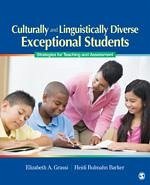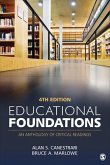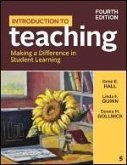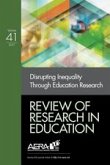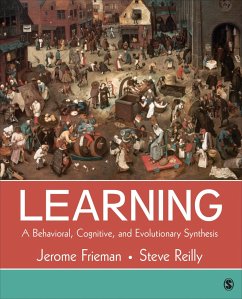Elizabeth A Grassi, Heidi B Barker
Culturally and Linguistically Diverse Exceptional Students
Strategies for Teaching and Assessment
Elizabeth A Grassi, Heidi B Barker
Culturally and Linguistically Diverse Exceptional Students
Strategies for Teaching and Assessment
- Broschiertes Buch
- Merkliste
- Auf die Merkliste
- Bewerten Bewerten
- Teilen
- Produkt teilen
- Produkterinnerung
- Produkterinnerung
Designed for primary and secondary teachers, this text connects theory to practice while presenting foundational teaching and assessment practices for culturally and linguistically diverse exceptional (CDLE) students. It examines current and alternative practices, explores the multicultural movement, and brings together foundational information from special education and ELL/bilingual fields to target the specific needs of CDLE students. Practical in nature, the book and its resources include hands-on suggestions for immediate classroom implementation, case studies, examples of authentic…mehr
Andere Kunden interessierten sich auch für
![Re-Designing Teacher Education for Culturally and Linguistically Diverse Students Re-Designing Teacher Education for Culturally and Linguistically Diverse Students]() Re-Designing Teacher Education for Culturally and Linguistically Diverse Students56,99 €
Re-Designing Teacher Education for Culturally and Linguistically Diverse Students56,99 €![Culturally and Linguistically Diverse Children Culturally and Linguistically Diverse Children]() Jerri A. HaynesCulturally and Linguistically Diverse Children20,99 €
Jerri A. HaynesCulturally and Linguistically Diverse Children20,99 €![Educational Foundations Educational Foundations]() Educational Foundations121,99 €
Educational Foundations121,99 €![Immigrant and Refugee Students in Canada Immigrant and Refugee Students in Canada]() Immigrant and Refugee Students in Canada39,99 €
Immigrant and Refugee Students in Canada39,99 €![Introduction to Teaching Introduction to Teaching]() Gene Erwin HallIntroduction to Teaching192,99 €
Gene Erwin HallIntroduction to Teaching192,99 €![Review of Research in Education Review of Research in Education]() Review of Research in Education111,99 €
Review of Research in Education111,99 €![Learning Learning]() Jerome FriemanLearning225,99 €
Jerome FriemanLearning225,99 €-
-
-
Designed for primary and secondary teachers, this text connects theory to practice while presenting foundational teaching and assessment practices for culturally and linguistically diverse exceptional (CDLE) students. It examines current and alternative practices, explores the multicultural movement, and brings together foundational information from special education and ELL/bilingual fields to target the specific needs of CDLE students. Practical in nature, the book and its resources include hands-on suggestions for immediate classroom implementation, case studies, examples of authentic student language, and video clips of teachers in action. The book is organized into four main sections: - Understanding student and family backgrounds - Strategies for assessment and planning for instruction - Strategies for content and language acquisition - Strategies for literacy instruction
Hinweis: Dieser Artikel kann nur an eine deutsche Lieferadresse ausgeliefert werden.
Hinweis: Dieser Artikel kann nur an eine deutsche Lieferadresse ausgeliefert werden.
Produktdetails
- Produktdetails
- Verlag: Sage Publications
- Seitenzahl: 432
- Erscheinungstermin: 1. November 2009
- Englisch
- Abmessung: 229mm x 185mm x 20mm
- Gewicht: 635g
- ISBN-13: 9781412952132
- ISBN-10: 1412952131
- Artikelnr.: 27174942
- Herstellerkennzeichnung
- Libri GmbH
- Europaallee 1
- 36244 Bad Hersfeld
- gpsr@libri.de
- Verlag: Sage Publications
- Seitenzahl: 432
- Erscheinungstermin: 1. November 2009
- Englisch
- Abmessung: 229mm x 185mm x 20mm
- Gewicht: 635g
- ISBN-13: 9781412952132
- ISBN-10: 1412952131
- Artikelnr.: 27174942
- Herstellerkennzeichnung
- Libri GmbH
- Europaallee 1
- 36244 Bad Hersfeld
- gpsr@libri.de
Elizabeth A. Grassi is Associate Professor of linguistically and culturally diverse education at Regis University. Prior to joining the Regis faculty, Elizabeth was a K-12 teacher and coordinator of ESL/language acquisition programs both in the United States and abroad.
Forward Preface 1. Introduction Establishing the Rationale: Demographics of Students in Our Classrooms Setting the Context: Laws That Impact Program Options for CLDE Students New Directions in Teacher Training Summary Activities for Further Understanding SECTION I: Understanding Student Backgrounds 2. Collaborating With Families Creating Relationships With CLD Families Considerations of Culture When Working With CLD Families Empowering Families Summary Activities for Further Understanding 3. Understanding Language Acquisition Interlanguage: The Journey From First Language to Second Language Proficiency Second Language Acquisition Theories Factors Affecting Second Language Acquisition Summary Activities For Further Understanding 4. Understanding Fluency Proficiency: What Does It Mean to Be "Fluent" in a Language? Cummins
s BICS and CALPS Model Canale and Swain
s Four-Part Model of Communicative Competence Summary Activities For Further Understanding Section II: Strategies for Assessment and Planning for Instruction 5. Strategies for the Assessment Process The Instruction/Assessment Cycle in Special Education Thes Eligibility Process and CLDE Students Tailoring Assessment Procedures for CLDE Students Summary Activities for Further Understanding 6. Collaboration Skills Diversifying the Concept of Collaboration Foundations of Collaboration Creating a Collaborative School Culture Co-Teaching as Collaboration Working With Paraprofessionals Summary Activities For Further Understanding 7. Planning Instruction Planning for Instruction A Philosophy of Differentiation Universal Design for Learning Application of Differentiation and UDL: Backward Design Planning Planning Pyramid for Instruction and RTI Planning and Classroom Management Summary Activities For Further Understanding 8. Culturally Relevant Pedagogy Introduction and Definitions Develop and Maintain Strong Teacher-Student Relationships Emphasize Consistent Dialogical Interaction Incorporate and Validate Space for Student Voice and Identity Make Content Relevant to All Students in the Classroom Summary Activities For Further Understanding Section III: Strategies for Content and Language Acquisition 9. Teaching Strategies: An Integrated Content-Language Approach Strategy 9.1: Making the Content Comprehensible With the 3-Way Model Strategy 9.2: Front-Loading and Emphasizing the Academic Language and Key Concepts of the Lesson Strategy 9.3: Accessing and Explicitly Teaching the Cultural and Content Schemata Needed for the Lesson Strategy 9.4: Allowing Students Time to Clarify in the First Language Strategy 9.5: Helping Students Organize and Access Academic Information: Explicit Strategy Instruction Summary Activities For Further Understanding 10. Strategies for Promoting the Participation Strategy 10.1: Creating a Comfortable Classroom Environment Strategy 10.2: Increasing Interaction in the Classroom: Heterogeneous Groupings Strategy 10.3: Encourage Extended Participation From CLDE Students Summary Activities For Further Understanding 11. Strategies for Explicit Grammar Instruction Language Errors Form-Focused Instruction Different Strategies for Teaching Grammar Summary Activities For Further Understanding Section IV: Strategies for Literacy Instruction 12. Strategies for Teaching Reading Reading Components and CLDE Students Language and Literacy Activities to Increase Background Knowledge Reading Strategy Instruction Strategies to Help Students Analyze, Organize, and Interact With the Content Summary Activities For Further Understanding 13. Strategies for Teaching the Writing Process Written Expression Challenges for Students With Special Needs Written Expression Challenges for CLDE Students Explicit Instruction of the Writing Process Example of Explicit Instruction of the Writing Process Summary Activities for Further Understanding 14. Challenges When Teaching Writing Specific Writing Challenges for CLDE Students Summary Activities For Further Understanding 15. Strategies for Written Error Correction Considerations When Correcting CLDE Student
s Writing Error Correction Summary Activities For Further Understanding
s BICS and CALPS Model Canale and Swain
s Four-Part Model of Communicative Competence Summary Activities For Further Understanding Section II: Strategies for Assessment and Planning for Instruction 5. Strategies for the Assessment Process The Instruction/Assessment Cycle in Special Education Thes Eligibility Process and CLDE Students Tailoring Assessment Procedures for CLDE Students Summary Activities for Further Understanding 6. Collaboration Skills Diversifying the Concept of Collaboration Foundations of Collaboration Creating a Collaborative School Culture Co-Teaching as Collaboration Working With Paraprofessionals Summary Activities For Further Understanding 7. Planning Instruction Planning for Instruction A Philosophy of Differentiation Universal Design for Learning Application of Differentiation and UDL: Backward Design Planning Planning Pyramid for Instruction and RTI Planning and Classroom Management Summary Activities For Further Understanding 8. Culturally Relevant Pedagogy Introduction and Definitions Develop and Maintain Strong Teacher-Student Relationships Emphasize Consistent Dialogical Interaction Incorporate and Validate Space for Student Voice and Identity Make Content Relevant to All Students in the Classroom Summary Activities For Further Understanding Section III: Strategies for Content and Language Acquisition 9. Teaching Strategies: An Integrated Content-Language Approach Strategy 9.1: Making the Content Comprehensible With the 3-Way Model Strategy 9.2: Front-Loading and Emphasizing the Academic Language and Key Concepts of the Lesson Strategy 9.3: Accessing and Explicitly Teaching the Cultural and Content Schemata Needed for the Lesson Strategy 9.4: Allowing Students Time to Clarify in the First Language Strategy 9.5: Helping Students Organize and Access Academic Information: Explicit Strategy Instruction Summary Activities For Further Understanding 10. Strategies for Promoting the Participation Strategy 10.1: Creating a Comfortable Classroom Environment Strategy 10.2: Increasing Interaction in the Classroom: Heterogeneous Groupings Strategy 10.3: Encourage Extended Participation From CLDE Students Summary Activities For Further Understanding 11. Strategies for Explicit Grammar Instruction Language Errors Form-Focused Instruction Different Strategies for Teaching Grammar Summary Activities For Further Understanding Section IV: Strategies for Literacy Instruction 12. Strategies for Teaching Reading Reading Components and CLDE Students Language and Literacy Activities to Increase Background Knowledge Reading Strategy Instruction Strategies to Help Students Analyze, Organize, and Interact With the Content Summary Activities For Further Understanding 13. Strategies for Teaching the Writing Process Written Expression Challenges for Students With Special Needs Written Expression Challenges for CLDE Students Explicit Instruction of the Writing Process Example of Explicit Instruction of the Writing Process Summary Activities for Further Understanding 14. Challenges When Teaching Writing Specific Writing Challenges for CLDE Students Summary Activities For Further Understanding 15. Strategies for Written Error Correction Considerations When Correcting CLDE Student
s Writing Error Correction Summary Activities For Further Understanding
Forward Preface 1. Introduction Establishing the Rationale: Demographics of Students in Our Classrooms Setting the Context: Laws That Impact Program Options for CLDE Students New Directions in Teacher Training Summary Activities for Further Understanding SECTION I: Understanding Student Backgrounds 2. Collaborating With Families Creating Relationships With CLD Families Considerations of Culture When Working With CLD Families Empowering Families Summary Activities for Further Understanding 3. Understanding Language Acquisition Interlanguage: The Journey From First Language to Second Language Proficiency Second Language Acquisition Theories Factors Affecting Second Language Acquisition Summary Activities For Further Understanding 4. Understanding Fluency Proficiency: What Does It Mean to Be "Fluent" in a Language? Cummins
s BICS and CALPS Model Canale and Swain
s Four-Part Model of Communicative Competence Summary Activities For Further Understanding Section II: Strategies for Assessment and Planning for Instruction 5. Strategies for the Assessment Process The Instruction/Assessment Cycle in Special Education Thes Eligibility Process and CLDE Students Tailoring Assessment Procedures for CLDE Students Summary Activities for Further Understanding 6. Collaboration Skills Diversifying the Concept of Collaboration Foundations of Collaboration Creating a Collaborative School Culture Co-Teaching as Collaboration Working With Paraprofessionals Summary Activities For Further Understanding 7. Planning Instruction Planning for Instruction A Philosophy of Differentiation Universal Design for Learning Application of Differentiation and UDL: Backward Design Planning Planning Pyramid for Instruction and RTI Planning and Classroom Management Summary Activities For Further Understanding 8. Culturally Relevant Pedagogy Introduction and Definitions Develop and Maintain Strong Teacher-Student Relationships Emphasize Consistent Dialogical Interaction Incorporate and Validate Space for Student Voice and Identity Make Content Relevant to All Students in the Classroom Summary Activities For Further Understanding Section III: Strategies for Content and Language Acquisition 9. Teaching Strategies: An Integrated Content-Language Approach Strategy 9.1: Making the Content Comprehensible With the 3-Way Model Strategy 9.2: Front-Loading and Emphasizing the Academic Language and Key Concepts of the Lesson Strategy 9.3: Accessing and Explicitly Teaching the Cultural and Content Schemata Needed for the Lesson Strategy 9.4: Allowing Students Time to Clarify in the First Language Strategy 9.5: Helping Students Organize and Access Academic Information: Explicit Strategy Instruction Summary Activities For Further Understanding 10. Strategies for Promoting the Participation Strategy 10.1: Creating a Comfortable Classroom Environment Strategy 10.2: Increasing Interaction in the Classroom: Heterogeneous Groupings Strategy 10.3: Encourage Extended Participation From CLDE Students Summary Activities For Further Understanding 11. Strategies for Explicit Grammar Instruction Language Errors Form-Focused Instruction Different Strategies for Teaching Grammar Summary Activities For Further Understanding Section IV: Strategies for Literacy Instruction 12. Strategies for Teaching Reading Reading Components and CLDE Students Language and Literacy Activities to Increase Background Knowledge Reading Strategy Instruction Strategies to Help Students Analyze, Organize, and Interact With the Content Summary Activities For Further Understanding 13. Strategies for Teaching the Writing Process Written Expression Challenges for Students With Special Needs Written Expression Challenges for CLDE Students Explicit Instruction of the Writing Process Example of Explicit Instruction of the Writing Process Summary Activities for Further Understanding 14. Challenges When Teaching Writing Specific Writing Challenges for CLDE Students Summary Activities For Further Understanding 15. Strategies for Written Error Correction Considerations When Correcting CLDE Student
s Writing Error Correction Summary Activities For Further Understanding
s BICS and CALPS Model Canale and Swain
s Four-Part Model of Communicative Competence Summary Activities For Further Understanding Section II: Strategies for Assessment and Planning for Instruction 5. Strategies for the Assessment Process The Instruction/Assessment Cycle in Special Education Thes Eligibility Process and CLDE Students Tailoring Assessment Procedures for CLDE Students Summary Activities for Further Understanding 6. Collaboration Skills Diversifying the Concept of Collaboration Foundations of Collaboration Creating a Collaborative School Culture Co-Teaching as Collaboration Working With Paraprofessionals Summary Activities For Further Understanding 7. Planning Instruction Planning for Instruction A Philosophy of Differentiation Universal Design for Learning Application of Differentiation and UDL: Backward Design Planning Planning Pyramid for Instruction and RTI Planning and Classroom Management Summary Activities For Further Understanding 8. Culturally Relevant Pedagogy Introduction and Definitions Develop and Maintain Strong Teacher-Student Relationships Emphasize Consistent Dialogical Interaction Incorporate and Validate Space for Student Voice and Identity Make Content Relevant to All Students in the Classroom Summary Activities For Further Understanding Section III: Strategies for Content and Language Acquisition 9. Teaching Strategies: An Integrated Content-Language Approach Strategy 9.1: Making the Content Comprehensible With the 3-Way Model Strategy 9.2: Front-Loading and Emphasizing the Academic Language and Key Concepts of the Lesson Strategy 9.3: Accessing and Explicitly Teaching the Cultural and Content Schemata Needed for the Lesson Strategy 9.4: Allowing Students Time to Clarify in the First Language Strategy 9.5: Helping Students Organize and Access Academic Information: Explicit Strategy Instruction Summary Activities For Further Understanding 10. Strategies for Promoting the Participation Strategy 10.1: Creating a Comfortable Classroom Environment Strategy 10.2: Increasing Interaction in the Classroom: Heterogeneous Groupings Strategy 10.3: Encourage Extended Participation From CLDE Students Summary Activities For Further Understanding 11. Strategies for Explicit Grammar Instruction Language Errors Form-Focused Instruction Different Strategies for Teaching Grammar Summary Activities For Further Understanding Section IV: Strategies for Literacy Instruction 12. Strategies for Teaching Reading Reading Components and CLDE Students Language and Literacy Activities to Increase Background Knowledge Reading Strategy Instruction Strategies to Help Students Analyze, Organize, and Interact With the Content Summary Activities For Further Understanding 13. Strategies for Teaching the Writing Process Written Expression Challenges for Students With Special Needs Written Expression Challenges for CLDE Students Explicit Instruction of the Writing Process Example of Explicit Instruction of the Writing Process Summary Activities for Further Understanding 14. Challenges When Teaching Writing Specific Writing Challenges for CLDE Students Summary Activities For Further Understanding 15. Strategies for Written Error Correction Considerations When Correcting CLDE Student
s Writing Error Correction Summary Activities For Further Understanding

